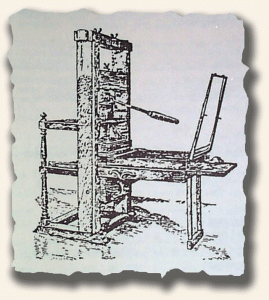More on printing newspapers in the 1700’s…
August 24, 2009 by TimHughes  Email This Post
|
Email This Post
|  Print This Post
Print This Post
This article is primarily taken from the April, 1996 edition of “Collectible Newspapers” edited by Rick Brown, whom we thank for this contribution. It offers some interesting insights into the printing & distributing of newspapers in the colonial and post-colonial era of the United States.
 Newspapers from the latter half of the 18th century were relatively scarce. One factor was that early settlers were busy clearing the land & otherwise making the land habitable & sustaining. Plus only a small percentage of the population had reading skills beyond that of the basic rudiments. Although most towns of any size by 1715 had tracts of land set aside for schools, few actually had schools built & in operation.
Newspapers from the latter half of the 18th century were relatively scarce. One factor was that early settlers were busy clearing the land & otherwise making the land habitable & sustaining. Plus only a small percentage of the population had reading skills beyond that of the basic rudiments. Although most towns of any size by 1715 had tracts of land set aside for schools, few actually had schools built & in operation.
Nearly all 18th century newspapers were edited & published by printers that had a general printing business and also printed pamphlets, books, broadsides, lottery tickets, etc. Many also sold merchandise, groceries, patent medicines, and a variety of other goods. Rags, which were used to make the paper , were scarce in the colonies so most of the paper was imported from England.
Newspapers were printed on wooden hand presses with each applicatoin of ink to paper requiring a pull of by lever and screw. It was not until around 1816 that the new iron Columbian press came into general use. Instead of a screw it used a series of compound levers that multiplied the pull of the operator. But still, all hand presses were slow & laborious. The forms had to be laid by hand and the ink was poor and of uneven quality. Types were frequently old and worn.
After the newspapers were printed, distribution difficulties were encountered. Circulation was confined, for the most part, to the towns in which they were published. They were distributed to the rural areas by postboys on horseback and by stagecoach drivers. The roads were bad & the postal system was slow. Subscribers were few & the cost of an issue relatively expensive so newspapers were typically handed around from one to another so that a single copy was ready by many. Even those who subscribed often failed to pay for their subscriptions.
It has been estimated that the largest circulation of a single newspaper during the earlier colonial period was about 350 and that only a few reached this high of a number of circulation. By the 1750’s circulation for larger city newspapers reached upwards of 600 of each issue printed and during the Revolutionary War some newspapers boasted circulations in excess of 2000. By 1790 most newspapers were printing less than 1000 copies but the very popular “Columbian Centinel” from Boston was printing over 4000 copies of each printing date.
Despite poor equipment, limited circulation, nonpaying subscribers, poor distribution facilities & the general unprofitability of publishing a newspaper, the number of newspapers being published continued to increase as the years went by. There were numerous failures, but new newspapers were established to replace them. From 1704 to 1820 about 1634 newspapers came to life and died. Of that number only two-thirds of them lived beyond three years.
If you liked this post, you may also enjoy...
- More on printing newspapers in the 1700’s (revisited)…
- Newspaper circulation in the 1700’s…
- Newspaper circulation in the 1700’s (revisited)…
- From the Library of Congress: “Printing Newspapers 1400-1900: A Brief Survey…”
- First newspapers in Hawaii…
Comments
3 Responses to “More on printing newspapers in the 1700’s…”
Feel free to leave a comment...
and oh, if you want a pic to show with your comment, go get a gravatar!





I think there were only a handful of newspapers in the late 1800’s. It seems to be going back in that direction now with many of the mainstream newspapers hurting for money.
Hello. I was wondering if I could get some information on how newspaper pages were numbered in the 18th century; I know they were chronological, but I noticed something recently that puzzled me. I bought a copy of the Boston Chronicle from December 1768 that is volume 1, number 53; but I was looking in a book recently that had a picture of an issue from October of the same year and noticed the page numbers were higher than mine from December. Do you know why it was numbered this way?
Thank you!
Aaron, This is a great question. In many (but not most) cases, volumes were not numbered at the start of a year, but were numbered from the start of their initial publication. So, if for example they were being numbered in volumes on a yearly basis, but their first issue was printed at the beginning of October, the numbers in each vol. would run from October through September of the following year. I am not sure if this is what happened with your Boston Chronicle issue, but it is my best guess.